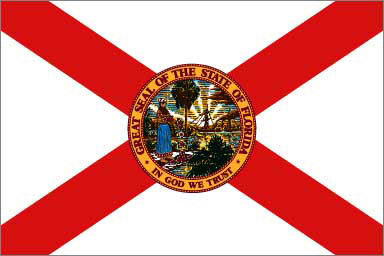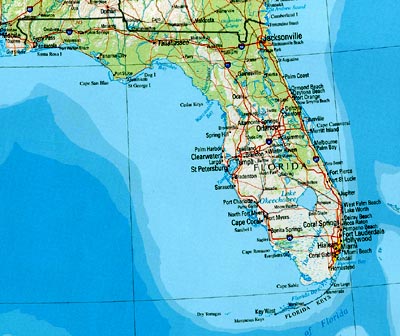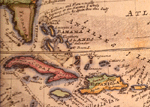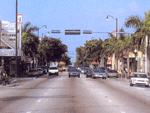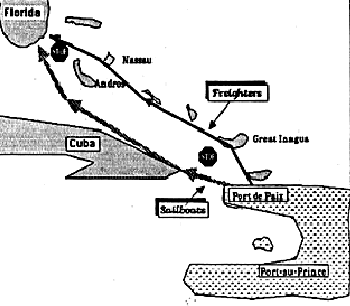FLORIDA
|
|
|
POPULATION:
19,900,000 (2015); 2,300,000 (20%) born outside the United States (4th highest
percentage in USA)
CAPITAL:
Tallahassee (182,000, 2012)
NAME:
State of Florida
ADMISSION
DAY: March 3, 1845 (27th state of U.S.A.)
STATE NICKNAME:
The Sunshine State
PRINCIPAL CITIES
(2014): Jacksonville (823,000); Miami (420,000); Tampa (359,000); Gainesville
city (128,500)
ETHNIC
GROUPS: 4,180,000 (2012) Hispanics and Latinos (4,370,000), which include
1,100,000 Cubans (more than 100,000 of whom arrived on Florida shores as
refugees in 1980), 550,000 Puerto Ricans, and 450,00 Mexicans; black
population: 3,135,000 (2012, 4th highest in USA); Asians: 494,000 (8th highest
in USA); native Americans: 95,000.
LANGUAGES: English (official), 76%; Spanish 17%; Creole, 1.5%; French, 1.0%;
RELIGIONS:
Protestant, 54%; Roman Catholic, 26%; Jewish, 4%; Mormon, 1%;
LIFE
EXPECTANCY (2012): 79.7
LITERACY
(2012): 99.8%.
MONEY: USA dollar
ECONOMY: tourism
GEOGRAPHY:
low-lying peninsula bordered by the Atlantic Ocean, the Strait of Florida, and
the Gulf of México
HISTORY:
13,000 BCE – 1512
C.E. Inhabited by hunter-gatherer
peoples at first, then, mainly, by Timucua, Calusa, Apalachee, and Tocobago
peoples, and last by Seminoles in later centuries up to the present.
2,000 BCE Timucua
people arrive from northern South America via the Caribbean island chain.
1513 Juan
Ponce de León, Spanish explorer and conquistador landed on Easter
Sunday, April 2-4 (la Pascua Florida); he landed at St. Augustine, but he made
no permanent settlement.
1526 The
Spanish explorer Vázquez de Ayllón tries but fails to establish a
Spanish foothold in Florida.
1527 The
Spanish explorers and conquistadors Pánfilo de Narváez and his
second-in-command, Álvar Núñez Cabeza de Vaca, fail
disastrously to establish a Spanish colony in Florida.
For
Cabeza de Vaca's narration of the Spanish conquistadors' arrival in La Florida,
see: => Cabeza de Vaca. Pánfilo de Narváez
and all but four men (among these Cabeza de Vaca and the Moorish slave,
Estevanico) died by 1528.
1539-1542 Hernando de
Soto, with 700 men, 9 ships, 220 horses, priests, and tons of equipment for
colonization and conquest, undertook a disastrous exploration of Florida
(especially the Bradenton and Tampa areas). He died on the Mississippi River
after wandering through much of the American Southeast. For a map of de Soto's
failed odyssey see: => De Soto map.
In 2012, archeologists discovered that de Soto and his massive party went
through Ocala, Micanopy, and Gainesville on their way through Florida.
1559-1561 Tristán
de Luna y Arrellano, Spanish conquistador, briefly settled Peñascola
(Pensacola)
1562-1565 French
Huguenot explorers and settlers (Jean Ribaut, René Gaumont de
Laudonnière, et al) explore and settle Charlesfort at Parris Island and
Fort La Caroline in Jacksonville
1565 Pedro
Menéndez de Avilés, Spanish conquistador and settler, founds San
Agustín on the lands of Chief Seloy’s village among the Timucua
nation.
Menéndez
de Avilés massacres the French colonists at La Caroline and the
survivors of Fort Caroline at Matanzas Bay.
1566-1587 The Spanish
empire, under the leadership of Menéndez de Avilés, establishes the
first capital of La Florida at Santa Elena on what is Parris Island in the U.S.A.
state of South Carolina. This substantial settlement and capital, north of San
Agustín, served the purpose of protecting the Spanish treasure fleets. From
Santa Elena, Spanish Jesuits and soldier-explorers founded other bases well
into the Appalachian Mountains. Due to attacks by English and French corsairs,
the Spanish crowd ordered the settlement destroyed in order to pull back to St.
Augustine. (The first English settlement in South Carolina was founded in 1670.)
1566 Site
of Miami and surrounding area claimed by Menéndez de Avilés as a
possession of Spain.
1567 The
first settlers of St. Augustine performed the first stage production, or
masque, in North America.
1572 St.
Augustine is reestablished on its current site.
1587 The
Franciscan mission of Nombre de Dios is established in St. Augustine near the
so-called Fountain of Youth on a site occupied since about 2000 BCE.
1606 La
Misión San Francisco de Potano is founded by Franciscan missionaries,
sent from the Misión Nombre de Dios in St. Augustine; the mission is
located 8 miles NW of Gainesville, Florida. (For more details, see: => St. Augustine #14b.
In northern and western Florida alone the Spanish government and church
established some 50 missions.
1610-1612 The
Franciscan mission of Santa Fe de Toloca was established north of Gainesville,
Florida, on or near the Santa Fe river. This mission connected the camino real (royal highway) between St.
Augustine and the San Luis de Apalachee mission in present-day Tallahassee (the
Apalachee province of New Spain in the first Spanish period). (Santa Fe College
was named for the river, but the mission had the same name.)
1672-1695 The Castillo
de San Marcos (Fort Marion under the English and Americans) was built in its
current form.
1693 Spain
declares by official royal edict that all African slaves who escape from the
English colonies would become free upon arriving in Spanish Florida, converting
to Roman Catholicism, and, for men, serving in the militia.
1727 For
a view of Florida’s place in geographical relationship to the English
view of the “West Indies” in the context of early 18th
century colonial Latin America, see the following map:
1729 The
last recorded living Timucuan native person dies.
1738 The
Spanish town and fort of Gracia Real de Santa Teresa de Mose (Fort Mose), first
completely free black settlement in what would become USA territory, built two
miles north of the Castillo in St. Augustine.
1740 Fort
Mose destroyed by English slave owners and their Indian allies in an invasion from
the Carolinas.
1763-1783 Florida was
ceded to England from Spain by the Treaty of Paris; Fort Mose reconstructed and
resettled, 1763.
1777 English
settles people from Minorca and other Mediterranean places in Florida.
1783 Florida
ceded back to Spain by the Treaty of Versailles
1783-1821 Second
Spanish period
1790 Don
Vicente Manuel de Zéspedes y Velasco, Spanish Brigadier General and
former governor of La Florida, sent a lengthy report to the king of Spain about
Spain’s precarious colonial situation in La Florida; in the report he
described the main problem facing Spanish control of the region: “those
who dwell in the interior of the southern states and who are called Crackers, a
species of white renegade” (The
Florida Historical Quarterly, October, 1984, p. 190).
1819 Florida
was ceded to the USA by the Adams-Onís Treaty. The Treaty was proclaimed
in 1821. (See note #1 below.)
1816-1845 Three
Seminole Wars in which the United States Army fought against and more or less defeats
the semi-native Seminole tribe of Florida: (1) 1816-1818, with Gen. Andrew
Jackson and Gen. E. P. Gaines; (2) 1835-1842 with Osceola and Billy Bowlegs;
(3) 1855-1856 with 100 Seminoles alive and hiding in the southern Florida
wetlands.
1821 Spain
sells East and West Florida to the United States of America. All Spanish
citizens either leave Florida for Cuba or become American subjects and
citizens; most blacks remaining in Florida revert to slave status again.
1845 Florida
becomes the 27th state of the USA as a “slave state.”
1860 Census
in St. Augustine: 1,938 slaves; 1,217 “white” residents; 90 free
blacks.
1861 Florida
secedes from the USA and joins the Confederate States of America.
1861-1865 American
Civil War
1865 The
Lincolnville neighborhood in St. Augustine becomes a segregated Afro-American
neighborhood.
1868 Florida
readmitted to the USA
1896 Miami
became an incorporated city. The pre-Spanish native inhabitants were the
Tequestas or the Mayami.. Miami was claimed for the king of Spain by Pedro
Menéndez in 1566.
1920
– 1929 Florida
land boom; internal American immigration from northern states.
1926 SW
Eighth Street, the core of a new shopping area west of downtown Miami, saw the
construction of the iconic Tower Theater. In 1931, the architect Robert Law
Reed remodeled into its current art deco style. Starting especially in the
1960s, after the Cuban Revolution began in 1959, SW Eight Street, with the
arrival of thousands of Cuban refugees, become the center of Little Havana, and
it became known as Calle Ocho. In March every year more than a million people
visit the Calle Ocho Open House fiesta. For Calle Ocho, see: =>
1950-1960 Immigration
of Haitian professionals to Florida. For example, 261 of 264 graduates of
Haitian medical schools left Haiti from 1957-1963.) Chart of Haitian migration:
|
|
1959
(Jan 1) Victory by Fidel
Castro in Cuba
1959-1962 1,000,000
Cubans immigrate to USA, principally Florida (others come later); 1980: 100,000
more Cubans arrived from Cuba
1972-1990 80,000
middle class and lower class Haitians arrived in Florida: the so-called
Boatpeople.
1979-1987 Robert
Graham, governor (Dem.).
1992 Hurricane
Andrew devastated southern Florida around the Miami area.
1991-1994 37,000 more
Haitians fled to Florida.
1999-2007 John Ellis
"Jeb" Bush (GOP) served as governor.
2006 Charles
Joseph Crist, Jr. (GOP) elected
governor
2007-2008 SFCC begins
offering HUM 2461, Humanities of Latin America.
50%
of all Cubans living in the United States live in Miami. Other Cuban population
centers in Florida are: Fort Lauderdale, Orlando, Tampa, Jacksonville.
Florida's
Hispanic population: 3,000,000.
2009 Major
art exhibition (glass and multi-media) by Therman Statom at the Orlando Museum
of Art (OMA) on Ponce de León and “Stories of the New World.”
2011
– 2014 Rick Scott (Republican)
was elected the 45th governor of the state of Florida.
2015
– 2019 Rick Scott
(Republican) re-elected as governor.
GOVERNMENT:
Representative democracy
MILITARY: State
patrol, local police, National Guard
CHIEF
EXECUTIVE: Governor Rick Scott (GOP)
MAJOR
POLITICAL PARTIES: Democratic Party, Republican Party
1.
The
Adams-Onís Treaty (1819) solved border disputes between the United
States and Spain in these areas: (a) East and West Florida were ceded to the
United States (West Florida then went all the way to the Mississippi River);
(b) the Sabine River in Texas; (c) firm boundary agreements between the USA and
Spain from the Rocky Mountains to the Pacific Ocean; (d) indemnification of $5,000,000.00 by the
USA for claims against the Spanish government; and (e) reaffirmation of terms
of the Louisiana Purchase.
